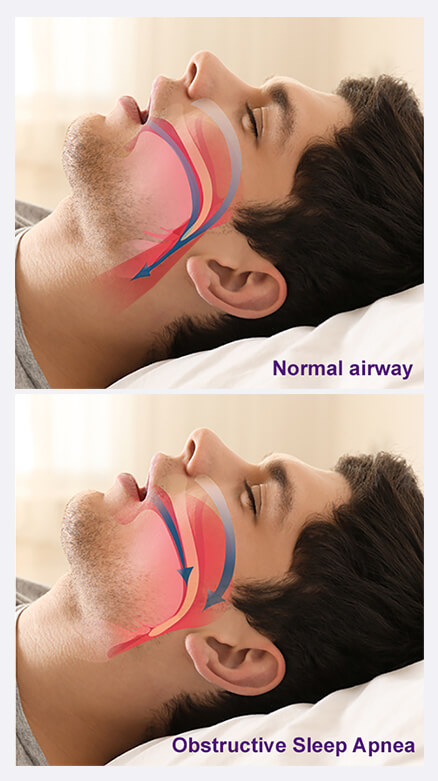What is Obstructive Sleep Apnea?
Derived from the Greek word for “lack of breath”, sleep apnea is a serious, potentially life-threatening sleep-related breathing disorder that is often linked with loud, heavy snorers, and affecting an estimated 45 million Americans. About 4% of middle-aged men and 2% of middle-aged women have the condition, according to the National Heart, Lung, and Blood Institute. Sleep apnea can be the result of an abnormality in the respiratory pacemaker in the brain (central sleep apnea) or, more commonly, it may be triggered by an obstruction in the upper airway (obstructive sleep apnea), which decreases the amount of inhaled air, collapsing the tissue in the back of the throat, and disrupting sleep. An episode of partial airway closing is called a sleep hypopnea.
Patients with OSA experience repetitive episodes of obstruction of the upper airway during sleep, lasting anywhere from 30 seconds up to two minutes. With no air flowing into the lungs, oxygen levels drop and carbon dioxide levels rise in the blood. The reduction in oxygen and increased carbon dioxide alert the brain to resume breathing and cause an arousal. Finally, the patient awakens with a jolt and resumes breathing, and quickly falls back to sleep — and resumes the loud snoring.
Blood pressure spikes up during the arousal, sometimes by as much as 30 mm Hg systolic, the top number in your hypertension reading. As the person goes back to sleep, typically unaware of having awakened, the throat muscles relax once again, the airway closes, and the sleep apnea pattern is repeated again. And again. And again. These subsequent and frequent arousals, although necessary for breathing to restart, prevent the patient from getting enough restorative, deep sleep.
There are two major types of sleep apnea. The most common is obstructive sleep apnea, or OSA, which affects upwards of 45 million Americans. Central sleep apnea (CSA), which is less common, is caused by a failure of the brain to signal the muscles to breathe.
A deep restorative sleep every night is essential to your good health.
During Wake stage (Normal Breathing), the tongue is kept active and the muscles around the throat are engaged to maintain airway patency. During Inhalation, the flow of air easily enters the throat to the lungs.
During Sleep stage, diminished signal from the brain results in relaxation of the throat’s soft tissue to collapse and the throat walls begin to narrow. This phenomenon can cause snoring and airway occlusions, thus reducing the amount of air reaching the lungs and dropping the blood’s oxygen levels.
Oxygen Deprivation will cause the sleeper to experience repeated “micro arousals”, which results in sleep interruption from a deep sleep state to a light sleep phase. It is during this time that evidence of snorting, choking or gasping for air is identified. Although not necessarily in a conscious state but technically awake, the sleeper may be quick to fall back asleep and this cycle starts over again.
The impacts of these micro-arousals are associated with excessive daytime sleepiness, mood irritability, concentration difficulties, low energy level, morning headaches, impaired memories…etc.

A deep restorative sleep every night is essential to your good health.
Signs & Symptoms of Obstructive Sleep Apnea (OSA):
Identifying OSA can be difficult as the “micro arousals” are often unidentified and the patients do not recall these events. A bed partner’s feedback about your nightly sleep habits is crucial in recognizing the clinical signs. If you are alone, monitoring with a Level 2 diagnostic device can assist with recordings of important parameters to identify presence of OSA.
The following signs and symptoms are common and are often used as part of an Obstructive Sleep Apnea evaluation:
- Fatigue or daytime sleepiness
- Breathing pauses during sleep
- Loud snoring
- Depression, memory lapses
- High blood pressure
- Sexual dysfunction
- Frequent morning headaches
- Sudden awakenings with a sensation of gasping or choking

Frequently Asked Questions about OSA?
The cycle of OSA starts with snoring and continues until the airway collapses or closes off. The person tries to breathe but is unable to get air into their lungs through the collapsed airway and an apnea (cessation of breathing) occurs. The brain realizes that it is not getting enough oxygen and fresh air so it wakes the person from a deep level, to a lighter level, of sleep. The airway then opens and normal breathing resumes. The person falls back into a deeper sleep, begins snoring again and the cycle repeats.
OSA affects about 1 in 5 Canadian adults which is about as common as diabetes, and OSA is quite significantly under-diagnosed.
Of the 20% of Canadians with Obstructive Sleep Apnea, about 6.5% have moderate to severe OSA. The remaining people have mild to moderate OSA.
